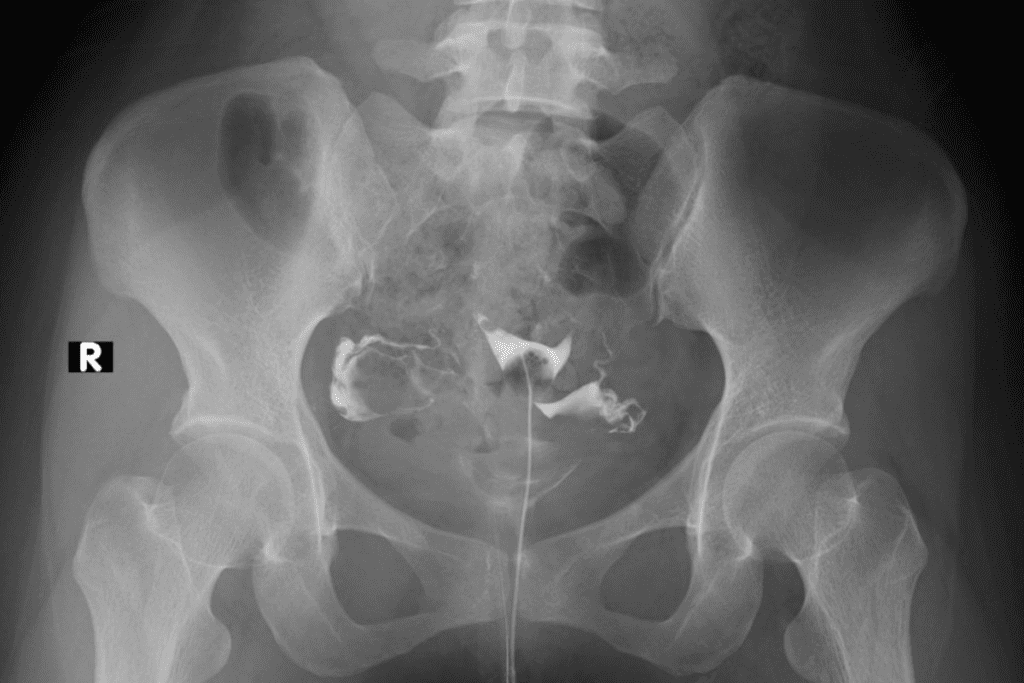Last Updated on October 31, 2025 by

Many women who have undergone a tubal tubal procedure often wish to have more children later in life. A tubal tubal reversal surgery aims to restore fertility by reconnecting the fallopian tubes, allowing eggs to travel normally for natural conception.
Choosing a tubal tubal reversal is a big decision. Our medical team provides expert guidance, advanced surgical care, and full support for international patients seeking safe and effective treatment options.
Before surgery, doctors carefully evaluate whether you’re a good candidate for the tubal tubal procedure. With modern microsurgical techniques, many women successfully achieve pregnancy after reversal, bringing new hope to those wishing to expand their families.
Understanding the details of a tubal ligation reversal is key. This surgery aims to help women who had tubal ligation regain their fertility.
The surgery is a detailed process to reconnect the fallopian tubes for pregnancy. Our surgeons employ advanced microsurgical techniques to fix the tubes. They remove the blocked parts and join the healthy parts together. This requires great skill and care for the best results.

The success of reversing a tubal ligation depends on the original method. Common methods include:
Knowing the original method is important. It affects how likely the reversal will be successful.
Before starting a tubal ligation reversal, our surgeons do a detailed check. They look at the tube’s length and health, the original ligation method, and the patient’s overall health and age. Scar tissue or damage can also play a role in success.
Success rates for tubal ligation reversal vary. They can be between 40% to 80%. This depends on the original ligation method and the patient’s age. By looking at these factors, we can give a better idea of success chances.
The success of tubal ligation reversal depends on many factors. Knowing these is key for realistic hopes and smart choices.

Age is a big factor in tubal reversal success. Women under 35 years old often see better results, with up to 84% success rates. But, success rates drop as age goes up.
The method of the original tubal ligation matters a lot. Methods that damage less and keep more tube length work better. Starting in 2015, many sterilizations remove the tubes, making reversals harder.
The length and health of the tubes after sterilization are key. Longer, healthier tubes are more likely to connect well and lead to pregnancy. Tube condition, including damage or scarring, also plays a role.
The surgeon’s skill and experience are very important. Surgeons with lots of experience in microsurgery and reversal tend to get better results. Their skill can greatly affect success, so choosing a skilled surgeon is critical.
Understanding these six factors helps women gauge their chances of tubal reversal success. We aim to offer full care and advice, ensuring our patients are well-informed and supported.
Modern surgery has changed how we reverse tubal ligation. These changes have made the process safer and more effective. Now, more women can try to have children again.
Oldly, reversing tubal ligation meant big cuts and long healing times. But now, minimally invasive options are the norm. These use smaller cuts, causing less damage and pain.
Methods like laparoscopic and robotic-assisted surgeries are now common. They cut down on hospital stays and pain after surgery. Studies show these methods are better than the old way.
“The shift towards minimally invasive surgery has been a game-changer for our patients,” says Dr. [Last Name], a leading specialist in reproductive surgery. “Not only do these techniques reduce recovery time, but they also minimize scarring and improve overall outcomes.”
Laparoscopic surgery uses small cuts for a camera and tools. It lets surgeons work on the tubes with great detail. Robotic-assisted surgery adds even more precision with better tools.
We use both methods for tubal ligation reversals. Our skilled surgeons make sure patients get the best care. The choice between the two depends on the patient and the surgeon.
New imaging and microsurgery have improved tubal ligation reversal. High-tech images help surgeons see the tubes better. This makes their work more precise.
We use advanced microsurgery, like high-powered microscopes, for the surgery. This focus on detail is key to success. For more on tubal ligation reversal, check out our detailed guide.
After a tubal ligation reversal, knowing what to expect is key. The path to pregnancy has many stages. Being informed can greatly help.
The first few weeks after surgery are for rest and gentle activities. Following your surgeon’s advice is vital for healing. You might feel some pain, bloating, and spotting, but these are usually short-lived and can be managed with medication.
It’s important to keep up with follow-up appointments. These visits help track your healing and catch any issues early.
Wait at least one menstrual cycle before trying to get pregnant. This helps the uterus get back to normal and reduces risks. It’s also a time to build up your physical and mental strength for pregnancy.
Our team will help you know when to start trying to conceive. We consider your recovery and health.
Pregnancy rates after reversal are promising, ranging from 55% to 80% in the first year. Success depends on age, the original sterilization method, and the fallopian tube’s condition.
“The success of tubal ligation reversal is highly dependent on several factors, including the woman’s age and the technique used for the original sterilization.”
Women who conceive after reversal do so naturally. The egg is fertilized in the fallopian tube, then travels to the uterus. Studies show higher success rates for women under 35.
Knowing about recovery and pregnancy after reversal is key. With the right care and support, many women have successful pregnancies after reversal.
It’s important to know the risks of tubal ligation reversal before making a decision. We aim to give you the best results. But it’s key to understand the possible complications that can happen.
Tubal ligation reversal, like any surgery, has risks. These can include infection, bleeding, pain, or problems with anesthesia. Our team works hard to lower these risks. But it’s good to know they exist.
Infection and bleeding are common surgical risks. We use the latest techniques and strict protocols to lessen these chances.
One big risk of tubal ligation reversal is ectopic pregnancy. This is when a fertilized egg implants outside the uterus, often in a fallopian tube. The risk of this happening after tubal ligation reversal is about 4-10%, which is higher than usual.
“The risk of ectopic pregnancy is a critical consideration for women undergoing tubal ligation reversal. It’s essential to be aware of the symptoms, which can include severe abdominal pain and vaginal bleeding.”
When thinking about tubal ligation reversal, it’s good to compare risks with other fertility options, like IVF. While IVF has its own risks, tubal ligation reversal is a more natural way to conceive for many women.
The cost of tubal ligation reversal can change a lot. It depends on where you are, the surgeon’s fees, and your insurance. It’s important to talk about these costs with your healthcare provider and insurance company.
Make sure to check with your insurance about what they cover. Some plans might pay for part or all of the procedure, while others might not.
Choosing to have a tubal ligation reversal is a big decision. It involves looking at the risks and benefits, other fertility options, and your personal situation. If you’ve had your tubes tied and want to reverse it, knowing what to expect is key.
At Liv Hospital, we offer top-notch healthcare and support for international patients. Our team aims to help you reach your reproductive goals, including tubal ligation reversal or other fertility treatments. We know many women who’ve had tubal ligation want to have children, and we’re here to help.
While tubal ligation reversal might work for some, it’s important to talk to a healthcare provider first. They can help figure out the best choice for you. Our experts will talk about the chances of success, risks, and what to expect. We focus on patient-centered care, making sure you’re informed and supported every step of the way.
Tubal ligation reversal is a surgery that reconnects blocked or severed fallopian tubes. It aims to restore fertility.
Yes, it’s possible to get pregnant after having your tubes tied. The success of the reversal depends on several factors. These include the original ligation method and your age.
Several factors affect the success of a tubal ligation reversal. These include your age, the original sterilization technique, and the length and quality of the remaining tube. The surgeon’s experience also plays a role.
There are different surgical approaches for tubal ligation reversal. These include traditional open surgery, laparoscopic, and robotic-assisted techniques. Our institution uses advanced imaging and microsurgical techniques for the best outcomes.
The recovery from a tubal ligation reversal takes a few weeks. Our team will guide you through the recovery process. They will advise on when to begin trying to conceive.
Tubal ligation reversal is generally safe. But, there are risks and complications to consider. These include surgical and anesthesia-related risks, as well as the risk of ectopic pregnancy.
The cost of tubal ligation reversal varies. It depends on the surgical approach and the institution’s fees. Our team will discuss the costs and insurance coverage with you.
Yes, it’s possible to get your tubes untied if you’ve had a tubal ligation in the past. Our experts will evaluate the feasibility of the reversal. They will guide you through the process.
The chances of a successful pregnancy after tubal ligation reversal vary. They depend on several factors, including your age and the original sterilization technique. Realistic pregnancy rates range from 55-80% within a year.
Yes, there are alternative fertility options if tubal ligation reversal is not possible. Our team will discuss these options with you. They will help you make an informed decision.
Subscribe to our e-newsletter to stay informed about the latest innovations in the world of health and exclusive offers!